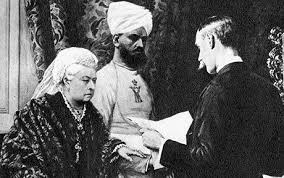
If you were travel up to north
India, say to cities like Lucknow, or Agra, and had conversations with the
‘small’ folk, or just people who had lived for generations, and whose lives did
not involve some kind of grand rupture, you would hear references to a
Rani Todiya, or
Mallka Todiya.
Rani Todiya
is used by such folk, as a marker of time; invariably of the good old days,
when things were cheap, when life was simpler, when there was a rule of law.
What is interesting however, is that these folk are not referring to some
Satyayug deity, but of the Queen-Empress
Victoria; the Victoria being compressed to
Todiya.
What is interesting about this term for Victoria is that not only is her reign
the marker for the good times, but it is also evidence of the manner in which
she had been internalized. Not only was her name transformed into a vernacular
form, but her position in society, as ‘their’ or ‘our’ Queen, was also to a
large extent internalized. The Empress Victoria reigned over an entire
psycho-social edifice, an edifice that transcended the seven seas,
incorporating native-rulers, castes, panchayats, producing in this manner, the
British Raj. The Raj to that extent was very ‘Indian’, as much as
Rani Todiya was our queen. This may come
as a surprise for those who have been raised on the nationalist intellectual
frameworks in use in schools. Frameworks that suggest to us, that there was
always an ‘us’ and a ‘them’ between the British and the Indians. What these
frameworks forget to mention however, is that when
Todiya was made our Queen, it was not just she who had a right over
us, but as is necessary in any form of kingship, we too had a claim on our
kings (and queens).

In a similar manner then, what we
in Goa, given the spectacular disinclination to teach our history in schools,
have largely forgotten, is that in addition to claiming the Portuguese kings
and queens as our own, we can also rightfully lay claim to three Spanish kings.
From 1580 until 1640,
the Portuguese crown was united with the Spanish crown,
allowing for two separate kingdoms, but just one King; a situation that ran its
course under the three Hapsburg Phillips of Spain.

With such a history in mind, the
Goan traveling in Europe has not merely a Portuguese link with that continent,
but larger European link. When traveling in the Netherlands, one thinks not
merely of the Dutch opponents of the early Estado da India Portuguesa, but also
of the fact that the Netherlands were once upon-a-time part of the Hapsburg
domains. Domains lost in the course of the wars that broke out in the continent
in the course of the Reformation. Similarly, when one travels to the one-time
imperial capital of Toledo in Spain, one does not start when one sees those
large double-headed eagles clutching the arms of the Hapsburg kings in their
talons. On the contrary, the emotion that one is faced with is that of pleasant
surprise when encountering the familiar. For did we not already see this motif
in Old Goa, proudly recording the sovereignty of Phillip, king of all of
Iberia?

The journey to Portugal was not,
as this column so often points out, to reconstruct some empty colonial saudadismo with regard to Portugal. On
the contrary, the trip to Portugal was to figure out if there were other ways
in which our relation to this country could be rearticulated in a contemporary
context. This contemporary context would not include only the examination of
the manner in which we can relate as South Asians, members of the Indian ocean
world, and as Indians, to Portugal. This
movement would also mean embracing its complex (sometimes obscured) histories
and giving them new relevance and meaning. In the course of this embrace, we are not bound to the nationalist interpretations of this history that the Portuguese may feel obliged to produce. On the contrary, we can legitimately rewrite this history from our own point of view. Embracing this history, making it
genuinely our own, allows us, in the manner that Mallka Todiya was claimed by her Indian subjects, allows us to make
similar claims on the heritage of the Philippine emperors. This claim of
inheritance should not ofcourse only be narrowly read, or shortsightedly
utilized, but more properly embraced, so that we effectively become citizens of
the world, a marked characteristic of the Goan (often an emigrant into this
large world).

Some may find this suggestion of embracing an Imperial heritage, especially by former subjects of the Empire, problematic. There is no denying that such an embrace is problematic. However, we should recognize that this embrace, while possibly problematic, also comes with its fair share of empowerment. It allows the contemporary resident of the global South, to go to foreign lands, in the knowledge that these lands that must today be crafted into home, were in earlier times, also home. This embrace also allows us to transcend the binaries of 'us' and 'them' and recognize commonalities that unite us outside of the frames that we normally use to see ourselves; constructing in this manner a common humanity.

Speaking of embracing this larger
heritage, and seeing ourselves outside of the frames we normally use, most
people would be surprised to realize that urinating on the street is not
particularly a crass Indian habit. All too often, one is apt to find
contemporary descendants of Philippine subjects, be they male or female, easing
themselves on the streets, especially late at night over the course of the
weekend. Come to think of it, this is not, and was not a practice unfamiliar in
the former realm of good Rani Todiya either! Some uncommon embraces it appears, can
engender uncommon perspectives.

